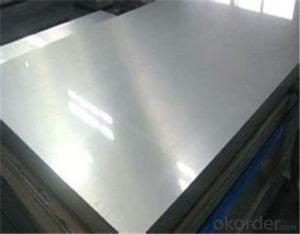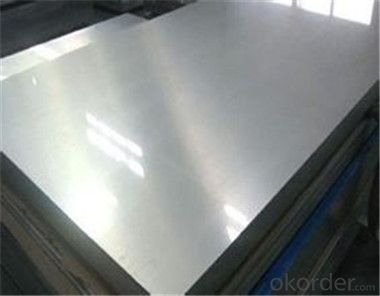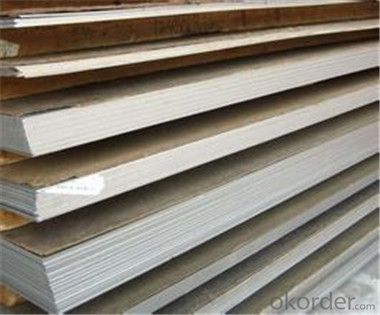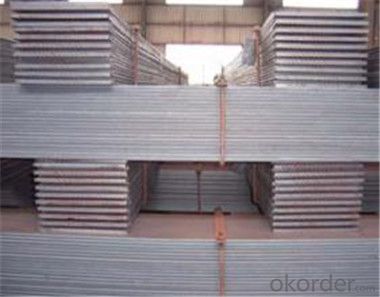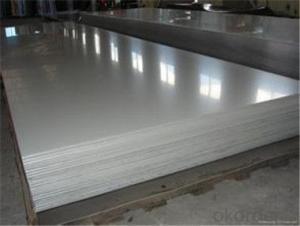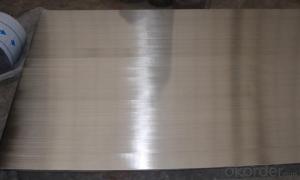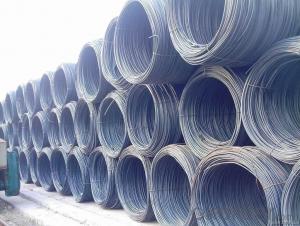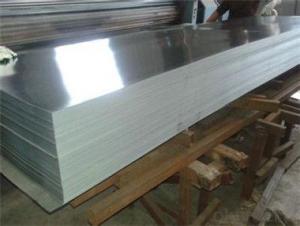Stainless Steel Sheet with Best Quality in China
- Loading Port:
- Tianjin
- Payment Terms:
- TT OR LC
- Min Order Qty:
- 50 m.t.
- Supply Capability:
- 45555555 m.t./month
OKorder Service Pledge
OKorder Financial Service
You Might Also Like
Specification
Description of stainless steel plate:
stanless steel sheet roll
Manufacturer since 2003;
Origin from Baosteel & Tisco;
100% Manufacture's direct deal.
Festures of stainless steel plate:
Material: 201
Finish: 2B, BA, No.4, HL
Thickness: 0.2mm~2.5mm
Size: 1000*2000mm,1219*2438mm or as per customers' request
Application: Kitchenware, decoration, construction and building ornament, product parts manufacturing and stainless steel products tooling and so on
Specifications of stainless steel plate:
Product Name | cr 1219x2438 stanless steel sheet 201 |
standared | JIS, AISI, ASTM, GB, DIN,SUS |
Thickness | 0.2mm~2.5mm |
Size | 1000*2000mm,1219*2438mm or as per customers' request |
Surface finish | 2B, BA, Hair Line, No.1,No.4, Mirror Finish |
Application | Kitchenware, decoration construction and building ornament, product parts manufacturing and stainless steel products tooling and so on |
Payment terms | T/T 30% for deposit, Balance against the copy of B/L; or L/C at sight |
Product Packing | wooden pallet |
Delivery time | within 15-20 working days after we got your 30% deposit |
Attention | FREE SAMPLES can be sent on request. We promise to provide our valued clients with high quality products, low price, and excellent client services. |
Images of stainless steel plate:

FAQ:
1. What is your package?
Packing situation: standard seaworthy packing or as customer required.
2. How long is the lead time?
Delivery time: 45 days after order confirmed.
3. What payment term do you accept?
Payment: T/T or L/C at sight.
- Q: How is steel wire rod used in the manufacturing of wire mesh shelves?
- Steel wire rod is used in the manufacturing of wire mesh shelves as it serves as the raw material for creating the wire mesh. The steel wire rod is first processed and drawn into thin wires, which are then woven or welded into a mesh pattern to form the shelves. This mesh structure provides strength, durability, and allows for proper ventilation and visibility in the shelves.
- Q: How is steel wire rod used in automotive applications?
- Steel wire rods are extensively used in automotive applications due to their high strength, durability, and flexibility. They are primarily used in the manufacturing of various automotive components such as springs, cables, tires, and reinforcements. Steel wire rods are also used in seat frames, exhaust systems, and suspension systems, where their excellent tensile strength and resistance to corrosion play a crucial role in ensuring the safety and performance of vehicles. Overall, steel wire rods are an essential material in the automotive industry, contributing to the overall strength, reliability, and functionality of automobiles.
- Q: How is steel wire rod used in the production of wire baskets and containers?
- Wire baskets and containers heavily rely on steel wire rod as a critical element in their production. Its primary purpose is to serve as the raw material for manufacturing the wires that shape the framework of these items. To kickstart the production process, the steel wire rod is loaded onto a wire drawing machine. This machine then pulls the rod through a series of dies, reducing its diameter and extending its length. This wire drawing procedure results in the creation of durable and flexible thin wires. Subsequently, these wires undergo further processing to achieve the desired shape and size for the wire baskets and containers. They are bent, twisted, and welded together to construct a solid and long-lasting framework. The steel wire rod provides the necessary strength and rigidity to withstand the weight and pressure these items encounter during use. Furthermore, steel wire rod not only provides structural support but also enhances the overall appearance of wire baskets and containers. It can be coated or treated to improve its visual appeal, allowing for customization to meet specific design requirements. Ultimately, steel wire rod plays a vital role in the production of wire baskets and containers. It serves as the foundation and structure, ensuring functionality, durability, and visual attractiveness.
- Q: What are the main factors influencing the choice of steel wire rod manufacturer?
- The main factors influencing the choice of steel wire rod manufacturer include the quality and consistency of the product, cost competitiveness, production capacity and reliability, adherence to industry standards and regulations, reputation and track record, technological capabilities, availability of customized products, and strong customer service and support.
- Q: How does the electrical conductivity of steel wire rod vary with different wire drawing processes?
- Different wire drawing processes can result in varying electrical conductivity for steel wire rods. Wire drawing involves pulling a wire rod through a series of dies to decrease its diameter and increase its length. This process can impact the electrical conductivity of the steel wire rod due to multiple factors. To begin with, reducing the diameter during wire drawing can lead to an increase in electrical conductivity. When the wire rod passes through the dies, its cross-sectional area decreases, resulting in a higher concentration of conductive material in a smaller space. This concentration of conductive material can enhance the electrical conductivity. Moreover, the wire drawing process can influence the microstructure of the steel wire rod, which subsequently affects its electrical conductivity. Deformation and strain during wire drawing can cause changes in the crystal structure and grain size of the steel. These changes significantly impact the electrical conductivity. For instance, grain refinement resulting from the wire drawing process enhances electrical conductivity by reducing electron scattering. Furthermore, the wire drawing process can introduce impurities or defects into the steel wire rod, which can disrupt its electrical conductivity. These impurities or defects act as scattering centers for electrons, thereby reducing the overall electrical conductivity. Additionally, the choice of lubricants and cooling methods during wire drawing can influence the electrical conductivity of the steel wire rod. Lubricants minimize friction and heat during the drawing process, preventing the formation of oxides or other surface contaminants that could hinder electrical conductivity. Effective cooling methods also maintain the desired microstructure and prevent the formation of detrimental phases that could impact electrical conductivity. In conclusion, the electrical conductivity of steel wire rods varies with different wire drawing processes. Factors such as diameter reduction, changes in microstructure, introduction of impurities or defects, and choice of lubricants and cooling methods all impact the electrical conductivity. Considering these factors carefully during the wire drawing process helps achieve the desired electrical conductivity for specific applications.
- Q: How is steel wire rod used in the production of electrical cables?
- Steel wire rod is used in the production of electrical cables as it serves as the core strength component. It provides structural support and enhances the durability and tensile strength of the cable. The steel wire rod is typically wrapped around the conductor and acts as a protective layer, preventing the cable from stretching or breaking under tension. Additionally, it helps to maintain the shape and integrity of the cable, ensuring reliable transmission of electricity.
- Q: What are the different types of steel wire rod surface defects and their repair methods?
- Steel wire rods can experience different types of surface defects, each necessitating a unique repair approach. Common defects include pits, scale, scratches, and cracks. Pits manifest as small cavities on the wire rod's surface, resulting from factors like corrosion or mishandling. To rectify pits, the affected area can be ground down and then polished to restore a smooth surface. Scale refers to the flaky residue that forms during the wire rod's manufacturing process. It can be eliminated through chemical agents or mechanical techniques such as brushing or blasting. Following scale removal, the wire rod can be coated with a protective layer to prevent future formation. Scratches are shallow grooves that can occur during handling or transportation. Minor scratches can be resolved by using abrasives or polishing compounds to buff them out. For deeper scratches, the affected area may need to be ground and then polished to match the surrounding surface. Cracks are more severe defects resulting from stress, improper cooling, or material flaws. Repairing cracks typically involves cutting out the affected section and subsequently welding or brazing it back together. In some cases, heat treatment may be necessary to restore the wire rod's strength and integrity. It's important to note that the repair methods mentioned may vary depending on the defect's severity and nature. It is always advisable to consult a professional or follow the manufacturer's guidelines to ensure appropriate repair of steel wire rod surface defects.
- Q: How is steel wire rod used in the manufacturing of wire forms for conveyor systems?
- Wire forms for conveyor systems rely on steel wire rod as a vital ingredient in their production. This wire rod acts as the base material from which wire forms are fashioned. To enhance its strength, ductility, and flexibility, the wire rod undergoes a series of mechanical and thermal treatments, such as hot rolling, cold drawing, and annealing. Once the wire rod has been appropriately processed, it is shaped into various wire forms that are specifically tailored for conveyor systems. Examples of these wire forms include wire mesh belts, wire spirals, wire ropes, and wire hooks. Each wire form has a distinct purpose within the conveyor system, whether it be supporting the weight of the conveyed material, guiding the movement of the conveyor belt, or securing and fastening different components of the system. The selection of steel wire rod for manufacturing wire forms for conveyor systems is based on its high tensile strength, corrosion resistance, and durability. These qualities ensure that the wire forms can withstand the demanding operating conditions of conveyor systems, such as heavy loads, high speeds, and exposure to various environmental factors. In conclusion, steel wire rod plays a critical role in the manufacturing of wire forms for conveyor systems by providing the necessary raw material with the required mechanical properties. Its utilization guarantees the dependable and efficient operation of conveyor systems across diverse industries, including mining, manufacturing, transportation, and logistics.
- Q: How does the yield strength of steel wire rod vary with different wire drawing processes?
- Different wire drawing processes can lead to variations in the yield strength of steel wire rod. Wire drawing involves reducing the wire's diameter by pulling it through a series of dies. The yield strength measures a material's ability to withstand stress without permanent deformation. The reduction in cross-sectional area is one factor that affects yield strength during wire drawing. As the wire passes through smaller dies, its diameter decreases, causing an increase in yield strength. This occurs because the reduction in cross-sectional area increases the density of dislocations within the wire, hindering their movement and making plastic deformation more difficult. Another factor influencing yield strength is the amount of strain induced during wire drawing. Strain refers to the deformation a material undergoes due to external forces. As the wire is drawn through the dies, it experiences significant strain, causing dislocations to rearrange and form a more organized structure. This can result in an increased yield strength. The temperature at which wire drawing occurs also impacts yield strength. Cold wire drawing, performed at room temperature, generally leads to higher yield strength compared to hot wire drawing, which is done at elevated temperatures. Cold wire drawing induces more strain hardening and promotes the formation of a finer microstructure, resulting in increased yield strength. The quality and cleanliness of the steel wire rod also play a role in its yield strength during wire drawing. Impurities and defects within the material can act as stress concentrators, reducing the overall strength of the wire. Therefore, using high-quality steel wire rod is important for achieving the desired yield strength. In summary, the yield strength of steel wire rod can vary depending on the wire drawing process, influenced by factors such as reduction in cross-sectional area, induced strain, temperature, and material quality. Understanding these factors is crucial for designing and optimizing wire drawing processes to achieve the desired mechanical properties for different applications.
- Q: How is steel wire rod used in the production of wire ropes for lifting applications?
- Steel wire rod is used as the primary raw material in the production of wire ropes for lifting applications. It is first drawn into wire strands, which are then twisted together to form a strong and durable rope. The high tensile strength and flexibility of steel wire rod make it an ideal choice for lifting heavy loads safely and efficiently. Additionally, the uniformity and consistency of the wire rod ensure the reliability and longevity of the wire ropes, making them suitable for various lifting applications.
Send your message to us
Stainless Steel Sheet with Best Quality in China
- Loading Port:
- Tianjin
- Payment Terms:
- TT OR LC
- Min Order Qty:
- 50 m.t.
- Supply Capability:
- 45555555 m.t./month
OKorder Service Pledge
OKorder Financial Service
Similar products
Hot products
Hot Searches
Related keywords
